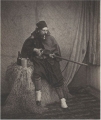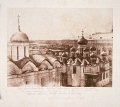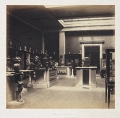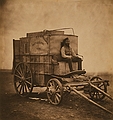| Dates: | 1819, 28 March - 1869, 8 August | | Born: | Great Britain, Lancashire, Nr. Bury, Crimble Hall | | Died: | Great Britain, London | | Active: | UK |
English photographer - best known for his work March 8 to June 26, 1855 during the Crimean War (1854-1856). This however does not do justice to the range of photographs he took that include still lifes, royal portraits, landscapes, museum record shots and architecture. A richly varied output was achieved in the ten year period (1852-1862) that he was involved in photography.
He was the founder and first Secretary of the Photographic Society of London in 1854, Fenton terminated his photographic career in 1861, after which his equipment and negatives were bought by Francis Frith. Prior to this, he had a varied photographic career and was one of the first photographers to photograph scenic views, stately homes and art works with an eye to selling copies to the public. A perfectionist in all things, Fenton worried about his photographs fading but some of his prints in the Royal Photographic Society Collection are in near mint condition.
[With thanks to Pam Roberts]
Stereographs project
Business locations
London, England, UK
[5-6] *"Photographed by..."; fine early photog.; made views of Crimean war; scarce views of England
on tan SCMs; views of North Wales in summer, 58,
prob. made for Negretti & Zambra; made outstanding
series of about 20 of exhibits in British museum,
some pub. under his own imprint, others by Lovell
Reeve. "Stoneyhurst and Its Environs.", boxed set,
pub. by Reeve; Reeve also either pub. or
merchandized many other of his views. For some
unknown reason Fenton auctioned his equipment and
negs. in 62; many negs bought by Francis Frith and
pub. by him after 69; B. 19, D. 69.
T.K. Treadwell & William C. Darrah (Compiled by), Wolfgang, Sell (Updated by), 11/28/2003, Photographers of the World (Non-USA), (National Stereoscopic Association) |
| Credit: National Stereoscopic Association with corrections and additions by Alan Griffiths and others. |
| NOTE: You are probably here because you have a stereograph to identify. Please email good quality copies of the front and back to alan@luminous-lint.com so we can create reference collections for all. |
Preparing biographies
Roger Fenton was a key figure in the first generation of photographers, and was captivated by the aesthetic potential of the new medium. In the 1850's he went to Russia to photograph Kiev, St Petersburg and Moscow, and was the official photographer of the Crimean War. In 1853 he was a founder of the London Photographic Society, which is now the Royal Photographic Society. In later life Fenton was official photographer to the royal family, but also took landscapes and still lifes, taking a particular interest in English gothic architecture.
This biography is courtesy and copyright of the Victoria & Albert Museum and is included here with permission.
Date last updated: 11 Nov 2011.
SHARED BIOGRAPHICAL INFORMATION PROJECT
We welcome institutions and scholars willing to test the sharing of biographies for the benefit of the photo-history community. The biography above is a part of this trial.
If you find any errors please email us details so they can be corrected as soon as possible. |
|
No photographer of his generation was more important to the field than Roger Fenton. Born into a freethinking and prosperous Lancashire family, Fenton entered University College, London, in 1836. Three years later he began the study of law, becoming a London barrister in 1851; but Fenton had broader ambitions than the law and by that autumn was in Paris studying art. In October Gustave Le Gray demonstrated the waxed-paper process to him, and by the next February Fenton was making his own photographs. In 1852 he also wrote the section on waxed paper for the new edition of Thornthwaiteís popular Guide to Photography. Fenton began to speak out in favor of establishing a society of photographers based on the one he had visited in Paris, and by 1853 his efforts had paid off with the founding of the Photographic Society (later the Royal Photographic Society) in London. Through his campaigning Fenton met the brilliant engineer Charles Blacker Vignoles, then engaged in building Europeís largest suspension bridge over the Dnieper River at Kiev. Vignoles engaged Fenton to photograph the work in large-format stereo negatives, and in August 1852 the two departed for Russia. Fenton succeeded brilliantly, submitting a selection of these photographs to the Society of Arts exhibition that opened in London at the end of the year - some of the more than forty waxed-paper works he contributed to the exhibition. These included architectural views, landscapes, and one study, Dead Stag, Zoological Gardens. Fentonís success was immediate and no one could match his impressive exhibition record. Every one of the major exhibitions in Britain was underpinned by Fentonís extensive and beautiful displays. He became the model photographer. In 1854 Fenton began to use wet collodion, at first selectively, then exclusively. His well-known Crimean photographs were all done in collodion, sensitized and developed in a converted wine merchantís van. After his return to Britain, Fenton worked exclusively with enormous glass negatives, a process at which he excelled. Through exhibitions and his active role in the Photographic Society, Fenton helped popularize the art of photography in the 1850s. Fentonís last public showing was in the 1862 International Exhibition in London. Stunning the photographic world by announcing the sale of all of his photographic equipment and negatives in October, Fenton returned to the practice of law.
Roger Taylor & Larry J. Schaaf Impressed by Light: British Photographs from Paper Negatives, 1840-1860 (Metropolitan Museum of Art, New York, 2007)
This biography is courtesy and copyright of the Metropolitan Museum of Art and is included here with permission.
Date last updated: 4 Nov 2012.
SHARED BIOGRAPHICAL INFORMATION PROJECT
We welcome institutions and scholars willing to test the sharing of biographies for the benefit of the photo-history community. The biography above is a part of this trial.
If you find any errors please email us details so they can be corrected as soon as possible. |
|
| | Premium content for those who want to understand photography |
References are available for subscribers.There is so much more to explore when you subscribe.
Subscriptions
| |
Family history
If you are related to this photographer and interested in tracking down your extended family we can place a note here for you to help. It is free and you would be amazed who gets in touch.
alan@luminous-lint.com |
|
Exhibitions on this website |
| | Premium content for those who want to understand photography |
Visual indexes for this photographer are available for subscribers.There is so much more to explore when you subscribe.
Subscriptions
Roger Fenton
British, 1819-1869
Fenton had the good fortune of being born into a wealthy family. His father had an extensive cotton mill and amassed a fortune. It was assumed that Fenton, after he completed his studies at University College London, would join his father manufacturing cotton. Instead, Fenton decided to study painting and wound up in Paris studying under Paul Delaroche. It was in Delaroche's studio that Fenton was introduced to photography by several eminent daguerreotypists who frequented Delaroche's studio. Upon his return to England, Fenton took up the calotype process and began making photographs. In 1847 Fenton, together with other photographers, formed the Calotype Club, the first photographic club in England. Although Fenton practiced photography for only ten years, he produced a large body of work photographing landscapes, still lives, architectural studies, portraiture, and oriental costume studies. However, it was his expedition to the Crimea in 1855 for which Fenton is best known
The appalling conditions suffered by the British troops in Sebastopol in the winter of 1854-5, due to mismanagement, was widely reported in The Times. The British people had little confidence in the government's ability to carry out the war and although the government tried to counter accusations, casualty lists showed otherwise. Of those who died, seven-eighths died from disease, while only an eighth died from battle wounds. It is not known if Fenton went to Sebastopol for political or commercial reasons, or both. His trip was made under the patronage of Queen Victoria, but was financed by newspaper publisher Thomas Agnew who wanted photographs which would be of historical interest and could be sold to the public. In order to not be offensive, Fenton could not portray the ravages of war. Instead he photographed the various encampments, the railway yard, the trenches and batteries, and groups of soldiers and officers. Although the photographs do not show the carnage of war, the barren landscape, the meager accommodations, and the shabbiness of the soldiers, tell of the devastation of war. In June of 1855 after spending three months near the battlefield, Fenton could take no more, and returned home.
His health was not good, he had contracted cholera, and he was depressed by the loss of friends on the battlefield. Upon his return to England, he was summoned for an audience with Queen Victoria to recount his adventures. When the Queen paid a state visit to Paris in August of that year, she took with her twenty of Fenton's photographs to show Napoleon. Soon after, Fenton was asked to visit Napoleon and Fenton presented his entire collection of 360 photographs from Crimea. The photographs from Fenton's Crimean expedition were frequently exhibited in late 1855 and early 1856. They were also published, in the form of engravings, in the Illustrated London News. Despite that they were widely viewed and much admired, the commercial sale of the photographs was very weak and Agnew lost money on the project. Undaunted, Fenton quickly moved on to other photographic projects.
[Contributed by Lee Gallery]
Roger Fenton
https://www.geh.org ...
| Roger Fenton, English (1819-1869)
https://albumen.stanford.edu ...
| Roger Fenton
https://www.loc.gov ...
Excellent site for background information on the Crimean War photographer.
| Roger Fenton
https://www.rogerfenton.org.uk
Roger Fenton‘s Letters from the Crimea
| Roger Fenton
https://www.tate.org.uk ...
Exhibition at the Tate Gallery in London (21 September 2005 - 2 January 2006)
| Roger Fenton - Crimean War Photographs
https://lcweb2.loc.gov ...
"Roger Fenton's Crimean War photographs represent one of the earliest systematic attempts to document a war through the medium of photography. Fenton, who spent fewer than four months in the Crimea (March 8 to June 26, 1855), produced 360 photographs under extremely trying conditions. While these photographs present a substantial documentary record of the participants and the landscape of the war, there are no actual combat scenes, nor are there any scenes of the devastating effects of war."
| Roger Fenton's Crimean letterbooks
https://fentonletterbooks.dmu.ac.uk
Faithful reproductions and transcripts of letters sent originally by Roger Fenton and subsequently copied out by family and friends during his "Photographic Trip to the Crimea" in 1855.
|
The following books are useful starting points to obtain brief biographies but they are not substitutes for the monographs on individual photographers. |
• Auer, Michele & Michel 1985 Encyclopedie Internationale Des Photographes de 1839 a Nos Jours / Photographers Encylopaedia International 1839 to the present (Hermance, Editions Camera Obscura) 2 volumes [A classic reference work for biographical information on photographers.]
• Beaton, Cecil & Buckland, Gail 1975 The Magic Eye: The Genius of Photography from 1839 to the Present Day (Boston and Toronto: Little, Brown & Company) p.44 [Useful short biographies with personal asides and one or more example images.]
• Capa, Cornell (ed.) 1984 The International Center of Photography: Encyclopedia of Photography (New York, Crown Publishers, Inc. - A Pound Press Book) p.191-192
• Lenman, Robin (ed.) 2005 The Oxford Companion to the Photograph (Oxford: Oxford University Press) [Includes a short biography on Roger Fenton.]
• Weaver, Mike (ed.) 1989 The Art of Photography 1839-1989 (New Haven and London: Yale University Press) p.456-457 [This exhibition catalogue is for the travelling exhibition that went to Houston, Canberra and London in 1989.]
• Witkin, Lee D. and Barbara London 1979 The Photograph Collector’s Guide (London: Secker and Warburg) p.142-143 [Long out of print but an essential reference work - the good news is that a new edition is in preparation.]
|
If there is an analysis of a single photograph or a useful self portrait I will highlight it here. |
|






